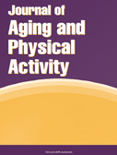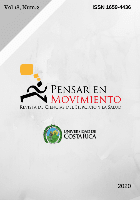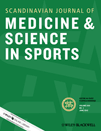
Measurement in Physical Education and Exercise Science
Scope & Guideline
Innovating Measurement for Health and Performance
Introduction
Aims and Scopes
- Measurement Validity and Reliability:
A core focus is on establishing the validity and reliability of various measurement tools and methods used in physical education and exercise science, including psychometric assessments and performance tests. - Psychometric Evaluation:
The journal prioritizes research that evaluates the psychometric properties of scales and instruments, ensuring they accurately assess constructs related to physical activity, motivation, and fitness. - Technology and Innovation in Measurement:
There is a strong emphasis on innovative technologies, including wearable devices and mobile applications, that enhance the measurement of physical performance and activity. - Intervention Studies:
The journal features research that explores the efficacy of physical activity interventions, including analyses of causal effects and outcomes related to health and fitness. - Population-Specific Assessments:
A notable area of contribution includes the development of measurement tools tailored for specific populations, such as children, older adults, and individuals with disabilities.
Trending and Emerging
- Wearable Technology and Mobile Applications:
There is a growing emphasis on the use of wearable technology and mobile applications for measuring physical activity and performance, highlighting the integration of technology in assessment practices. - Causal Analysis and Methodological Synergies:
Recent studies are increasingly focusing on causal analysis and methodological synergies, demonstrating a trend towards complex analyses that combine various research methods to derive meaningful insights. - Psychosocial Constructs in Physical Activity:
Emerging research highlights the importance of psychosocial constructs, such as motivation and self-efficacy, in understanding physical activity behaviors, underscoring the need for comprehensive measurement tools. - Adaptation and Validation of Measurement Instruments:
There is a notable trend in the adaptation and validation of measurement instruments for diverse populations, ensuring that assessments are culturally relevant and psychometrically sound. - Dynamic and Longitudinal Measurement Approaches:
A shift towards dynamic and longitudinal measurement approaches is evident, with researchers increasingly interested in how physical activity and fitness levels change over time.
Declining or Waning
- General Health and Fitness Assessments:
Research focused solely on general health and fitness assessments, without specific application or contextual relevance, appears to be less frequent, possibly overshadowed by more targeted or innovative measurement approaches. - Traditional Measurement Techniques:
There is a noticeable reduction in studies using traditional measurement techniques that do not incorporate modern technology or innovative methodologies, indicating a shift towards more advanced measurement practices. - Static Measurement Protocols:
Studies that rely on static or single-time-point measurement protocols are decreasing, as researchers increasingly favor dynamic and longitudinal approaches that capture variations over time.
Similar Journals

JOURNAL OF AGING AND PHYSICAL ACTIVITY
Shaping the dialogue on aging and active lifestyles.JOURNAL OF AGING AND PHYSICAL ACTIVITY is a premier academic journal dedicated to advancing the understanding of the multifaceted interactions between aging and physical activity. Published by Human Kinetics Publishers, this journal serves as a vital platform for researchers, practitioners, and students in geriatrics, gerontology, physical therapy, rehabilitation, and sports science. With an impact factor reflecting its influential contributions, the journal is classified in multiple categories, including Q2 rankings in both Physical Therapy, Sports Therapy and Rehabilitation and Rehabilitation. The scope of the journal spans from 1996 to 2024, encompassing a wealth of research that informs best practices and interdisciplinary collaborations on enhancing the quality of life for older adults. While the journal is not open access, it remains an essential resource for those committed to fostering healthier aging through evidence-based practices and innovative research.

Journal of Exercise Rehabilitation
Igniting Discussions on the Future of Rehabilitation ScienceThe Journal of Exercise Rehabilitation is a leading academic publication dedicated to advancing the field of physical therapy, sports therapy, and rehabilitation. Published by the Korean Society of Exercise Rehabilitation, this open-access journal, available since 2013, facilitates the dissemination of high-quality research and innovative practices in exercise rehabilitation. With an impressive impact factor and an H-index reflecting its academic influence, the journal is ranked in the Q2 category for Physical Therapy and Sports Therapy and Rehabilitation, and Q3 for Orthopedics and Sports Medicine as of 2023. Operating from South Korea, it serves as a vital platform for researchers, practitioners, and students alike, fostering collaboration and the sharing of knowledge across borders. By including studies that span from 2017 to 2024, it not only highlights significant advances in the field but also encourages ongoing exploration and discussion. Engage with the Journal of Exercise Rehabilitation to contribute to this dynamic and evolving discourse in rehabilitation science.

Biomedical Human Kinetics
Pioneering Discoveries in Human Performance and TherapyBiomedical Human Kinetics, an esteemed academic journal published by SCIENDO, focuses on the intricate intersections of human movement, rehabilitation, and the study of physical therapies. Since its transition to an open access model in 2009, this journal has become a vital platform for sharing groundbreaking research and innovative methodologies in the fields of Orthopedics, Sports Medicine, and Physical Therapy. With an ISSN of 0043-9630 and an E-ISSN of 2080-2234, it operates out of Poland, providing global access to high-quality research. The journal’s standing in 2023 is notable, ranking in the Q3 category for both Orthopedics and Sports Medicine and Physical Therapy, Sports Therapy, and Rehabilitation, reflecting its commitment to fostering academic discourse within these important and evolving domains. Furthermore, with Scopus rankings placing it in the 36th percentile in its categories, Biomedical Human Kinetics is recognized for its contributions to the academic community. As it converges research efforts from 2016 to 2024, this journal serves as a cornerstone for researchers, professionals, and students dedicated to enhancing human health and performance through informed scientific exploration.

Palaestra
Cultivating scholarly dialogue in health and education.Palaestra is a premier journal dedicated to the field of physical education, health, and sport studies, published by Sagamore Publishing LLC. With a commitment to advancing knowledge and practical applications in these dynamic fields, Palaestra serves as a vital resource for researchers, educators, practitioners, and students alike. The journal features a diverse range of high-quality articles that cover topics such as pedagogical strategies, fitness, sports science, and public health, facilitating critical discussion and innovation. Although it does not operate under an open-access model, Palaestra remains influential in the academic community, with a reputation for rigorously reviewing submissions and promoting scholarly dialogue. Located in Champaign, Illinois, the journal emphasizes the importance of bridging theory and practice, making it an invaluable platform for sharing advancements that shape the future of physical education and health initiatives.

Acta Kinesiologica
Elevating research in physical education and exercise science.Acta Kinesiologica is a distinguished journal dedicated to advancing the fields of kinesiology and health sciences. Published by the DRUSTVO PEDAGOGA TJELESNE & ZDRAVSTVENE KULTURE, this journal serves as a vital platform for researchers, professionals, and students to disseminate and engage with innovative findings in physical education, exercise science, and health promotion. With the ISSN 1840-2976 and E-ISSN 1840-3700, Acta Kinesiologica highlights contemporary research methodologies and interdisciplinary approaches that aim to enhance human movement and well-being. Although currently not an open-access journal, it is recognized for its commitment to quality and scholarly excellence. Researchers from around the globe benefit from its rigorous peer-review process, which ensures that only the most relevant and impactful studies are published. As the journal continues to evolve, it remains an essential resource for those seeking to expand their knowledge and contribute meaningfully to the scientific community in kinesiology and related disciplines.

MHSalud-Revista en Ciencias del Movimiento Humano y la Salud
Advancing knowledge in human movement and health.MHSalud-Revista en Ciencias del Movimiento Humano y la Salud is a prominent open-access journal published by the UNIV NAC, ESCUELA CIENCIAS DEPORTE in Costa Rica since 2004, dedicated to advancing research in the fields of human movement sciences and health. With an ISSN of 1659-097X, this journal serves as a vital platform for the dissemination of innovative findings related to biomechanics, rehabilitation, sports medicine, and public health. Although it currently holds a Q4 classification across various relevant categories such as Biophysics and Orthopedics, the journal is committed to fostering scholarly communication and bridging the gap between research and practice in these critical areas. The accessible nature of its content allows both seasoned researchers and emerging scholars to engage with research findings, while its focus on diverse health topics ensures its relevance in a rapidly changing academic landscape. As the journal continues to evolve through 2024 and beyond, it remains a crucial resource for professionals, students, and academics aiming to contribute to the understanding and improvement of human health and movement.

Pensar en Movimiento-Revista de Ciencias del Ejercicio y la Salud
Empowering research for a healthier tomorrow.Pensar en Movimiento - Revista de Ciencias del Ejercicio y la Salud is a distinguished peer-reviewed journal published by Universidad de Costa Rica, Escuela de Educación Física y Deportes. With an ISSN of 1409-0724 and an E-ISSN of 1659-4436, this Open Access journal has been a pivotal platform for scholarly communication since its inception in 2001. Dedicated to advancing the fields of exercise sciences and health, the journal provides a robust forum for researchers, professionals, and students to share high-quality research, innovative practices, and critical insights. As an essential resource in the Latin American academic landscape, it fosters interdisciplinary dialogue and promotes evidence-based practices in physical education and health. Researchers and practitioners alike will find valuable content aimed at enhancing physical activity, wellness, and health education, making it a vital tool for those committed to improving public health and promoting an active lifestyle.

Sport TK-Revista Euroamericana de Ciencias del Deporte
Fostering Collaboration in Sports Therapy and RehabilitationSport TK-Revista Euroamericana de Ciencias del Deporte is a prestigious open access journal published by the University of Murcia in Spain, focusing primarily on the interdisciplinary fields of sports science, occupational therapy, physical therapy, and rehabilitation. Since its inception, the journal has gained recognition for disseminating original research and scholarly articles that contribute significantly to the advancement of knowledge in these domains. With an ISSN of 2340-8812 and an E-ISSN also of 2340-8812, Sport TK has been committed to open access since 2012, enhancing its global reach and accessibility for researchers, professionals, and students alike. The journal's current rankings indicate its relevance, being classified in quartile Q3 in Complementary and Manual Therapy and Q4 in several other categories such as Education and Physical Therapy. By bridging academic inquiry with practical application, Sport TK plays a pivotal role in promoting evidence-based practices and fostering collaboration amongst professionals dedicated to health and wellness in the sports sector.

Physical Activity Review
Fostering collaboration through cutting-edge research in physical activity.Welcome to the Physical Activity Review, a dynamic platform dedicated to advancing the understanding of physical activity across various domains including health, education, and rehabilitation. Published by PROJACK, this Open Access journal has been committed to disseminating valuable research since its inception in 2013. With an ISSN of 2300-5076, the journal encompasses a wide range of interdisciplinary topics that address the critical role of physical activity in promoting health and well-being. The Physical Activity Review is classified within the Q3 quartile across key categories such as Education, Health (social science), Orthopedics and Sports Medicine, and Physical Therapy, Sports Therapy and Rehabilitation, reflecting its substantial impact and relevance within these fields. The journal proudly maintains a growing presence in Scopus rankings, underscoring its commitment to high-quality research and contribution to the scientific community. By providing researchers, professionals, and students with new insights and methodologies, the Physical Activity Review plays an essential role in fostering knowledge and collaboration in physical activity research.

SCANDINAVIAN JOURNAL OF MEDICINE & SCIENCE IN SPORTS
Advancing the Science of Sports Medicine.SCANDINAVIAN JOURNAL OF MEDICINE & SCIENCE IN SPORTS, published by Wiley, stands at the forefront of research in the fields of orthopedics, sports medicine, and physical therapy. Established in 1991, this prestigious journal has built a strong reputation, reflected in its Q1 ranking across multiple categories including Orthopedics and Sports Medicine, and Physical Therapy and Rehabilitation, as of 2023. With a discerning focus on innovative research and practical applications, the journal publishes high-quality studies that advance the understanding of sports performance and rehabilitation strategies. Although it does not offer open access, it remains accessible through various institutional subscriptions, ensuring that both practitioners and academics can benefit from its findings. The journal's commitment to excellence is further evidenced by its impressive Scopus rankings, placing it in the top 94th percentile within its respective fields. As the athletic landscape continues to evolve, SCANDINAVIAN JOURNAL OF MEDICINE & SCIENCE IN SPORTS serves as an essential resource for researchers, clinicians, and students dedicated to improving health outcomes in sports and exercise.